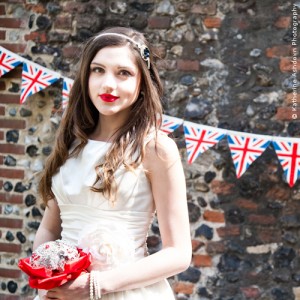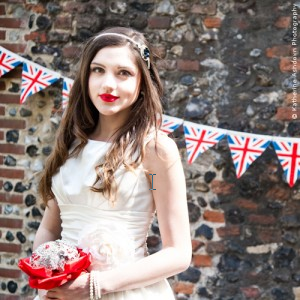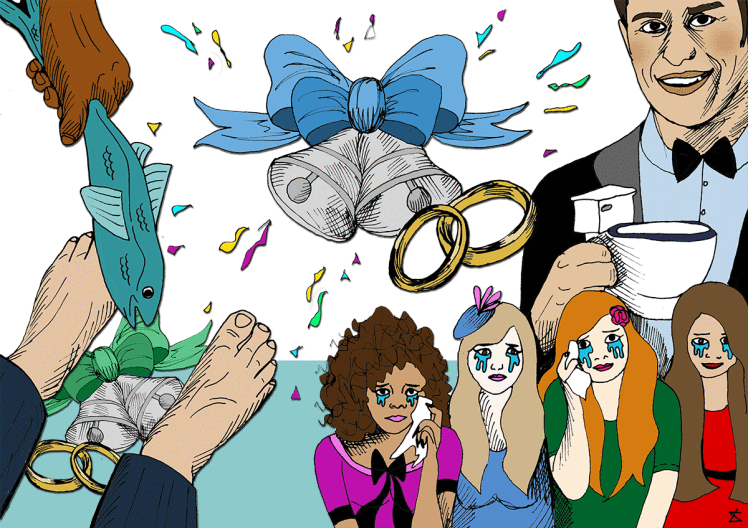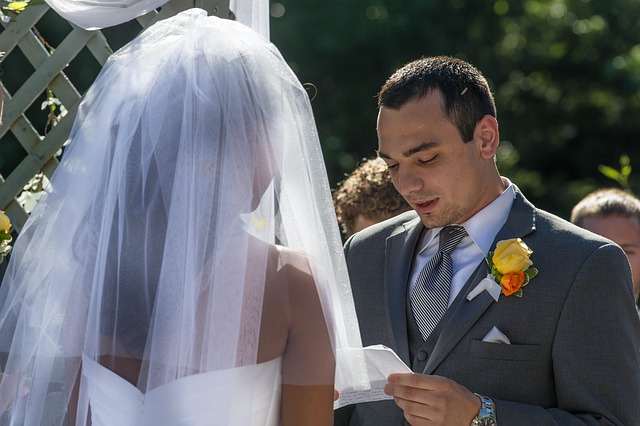A-Z British Wedding Traditions

Wedding traditions are part of one’s nature. And each country has a unique one that has been passed on from generation to generation.
And we are happy to share with you this A-Z of UK’s tradition that we hope you can pass on to the next generations.
The A-Z of British wedding traditions and etiquette
A is for Arrival
British wedding traditions state that the bride stands to the right of her Father. They lead the procession, followed by the bridesmaids and pageboys.
We love the new trend for sending the bridesmaids in first, not only does it help build the excitement even more, but it gives you a few more moments alone with your Dad before making your grand entrance.
B is for Bridesmaids
Traditionally, bridesmaids were used to help ward off evil spirits, dressing similarly to the bride. Today, many brides choose to dress their girls in outfits that flatter their figures – much kinder in our book!
C is for Children
Banning kids works if it’s a very formal or evening-based affair. If you are not inviting children, simply don’t put their names on the invitation. If you’re inviting an 18-year old who lives at home, they should receive their own invitation.
D is for Dance
The first dance can be daunting but it’s best to have one picked out as even the most shy of couples will find themselves encouraged out for a twirl. Etiquette dictates the groom should also dance with both mothers, the bride with both fathers, the mother of the bride with the father of the groom and vice versa and the best man with the chief bridesmaid, too!
E is for Engagement
The father of the bride should publish an engagement announcement in the newspaper as follows… The engagement is announced between Thomas, elder son of Mr and Mrs John Sampson of Knutsford, Cheshire, and Fiona, only daughter of Mr and Mrs George Delilah of Wrexham, Cheshire.
F is for Favours
Traditionally, five prettily-wrapped almonds would be given representing fertility, longevity, wealth, health and happiness. Modern alternatives are CDs, miniatures and lottery tickets.
G is for Gift List
Traditionally, one would wait to see who was attending before sending out a gift list, but times have changed! It’s pretty standard to include a gift card with the invitation nowadays. Many couples ask for money towards a honeymoon or replacing older items at home.
H is for Honeymoon
Etiquette says the groom should organise the honeymoon as a surprise for his bride. However, in reality, it’s so important to the bride that it’s likely the destination will be a joint choice – if not just hers!
I is for Invitations
Remember that guests can be invited to just the reception or evening celebrations if space is tight. If an invitation hasn’t been received it’s the height of rudeness to ask for one, and the same goes for asking about a plus one. Some traditional rules shouldn’t be broken!
J is for Jewels!
No rings should be worn aside from the engagement ring, worn on the right hand, leaving the wedding ring finger free. The engagement ring goes back on the left hand after the ceremony.
K is for Keepsakes
Gifts for the mums are a great idea. Bouquets presented by the groom or best man during their speeches work well, as do jewellery or even hand-written letters thanking them for their help
with the preparations.
L is for Lingerie
Or garters to be exact! The groom traditionally removes this from the bride and tosses it to male friends. Whoever catches it should place it on the left leg of the girl who caught the bouquet!
M is for Morning coat
Once upon a time, weddings took place in the morning and gentlemen wore their morning attire, hence the ‘morning suit’. These days, black tie is the norm at formal functions, while lightweight suits are best for weddings abroad.
N is for No Show
Guests not turning up without warning is obviously a big no no! However, should this happen, delegate to a bridesmaid or planner to have the tables rearranged and settings taken away so you don’t leave some guests stranded next to empty seats!
O is for Order of Service
A typical order of service will run as follows:
- Entrance of the Bride
- Welcome and Introduction by the celebrant
- Hymn
- Readings
- Sermon
- Exchange of Marriage Vows
- Prayers; Hymn
- The Signing of the register
- The Final Blessing
- Exit
Religious music and readings are not allowed at civil ceremonies so discuss your choices with the registrar early on. Many couples choose to say their own vows, too.
P is for Photos!
Reportage photography has been popular, but tradition is making a comeback with a resurgence in beautifully-posed shots.
Q is for Questions
Pre-empting guests’ queries is good etiquette, and avoids awkward phone calls and anxiety during the hectic planning process. Make certain all possible information is given to the guests to avoid unnecessary questions such as: Are children invited? Parking facilities? Wedding presents, and so on. Using a personal website means helpful information can easily be conveyed to guests ahead of schedule.
R is for Receiving Line
The purpose of a receiving line is for the hosts of the wedding and the bridal party to welcome all guests, but many couples now prefer to circulate between courses – a much more personal touch.
S is for Speeches
The first wedding speech is given by the father, ending with a toast to the bride and groom. Make sure the groom then thanks the bride’s parents and the guests, before making a toast to the bridesmaids. Finally, it’s the best man!.
T is for Table Plans
Wedding etiquette dictates that the top table should be, from the left: Chief bridesmaid, groom’s Dad, bride’s Mum, groom, bride, bride’s Dad, groom’s Mum, best man. This is often a nightmare, though, especially if there are tricky family situations to manage. Sometimes it’s best to try a non-traditional plan with two or three ‘top’ tables with parents hosting their own tables, leaving the bride and groom to sit with their friends.
U is for Ushers!
Ushers are the floor managers of the big day. They make sure guests are in the right place at the right time. They also set the tone as they are the first faces guests see. Good manners are essential!
V is for Veils
Strictly speaking, veils are inappropriate for second timers or pregnant brides. Having said that, these days it’s more about what looks good rather than symbolism, so why not?
W is for Wedding Cake
Traditionally, wedding cakes were grandiose, tiered, white-frosted fruit cakes, but today anything goes! Let your personality shine through, whether you prefer something sweet and rich, cupcakes or even a ‘cheese’ cake!
X is for X boyfriends
Etiquette says it’s okay to invite your exes if you are on good terms, but obviously it depends on how your intended feels about them.
Y is for You
Although you want to follow the rules, remember this wedding is all about you so make it a day that resembles your personality and that you will both remember for years to come as your perfect moment. Trust your instincts, and never mind everyone else’s opinions!
Z is for Zzzz
Although you’ll want to party the night away, it’s the done thing to accommodate those who might need a snooze! Make sure there is somewhere comfortable and safe for elderly relations, friends, or babies to have a quiet snooze if necessary.





